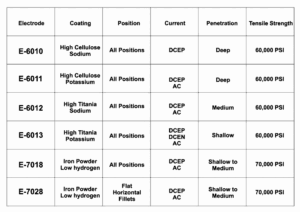
welding rod specification-
Welding rod specifications can vary depending on the type of welding process and the specific application. However, I can provide you with a general overview of welding rod specifications:
Welding Rod Classification: Welding rods are classified according to standards set by organizations such as the American Welding Society (AWS) or International Organization for Standardization (ISO). The classification system provides information about the welding rod’s characteristics, such as the welding process, type of coating, and material composition.
Welding Process: Different welding processes, such as Shielded Metal Arc Welding (SMAW), Gas Tungsten Arc Welding (GTAW), or Flux-Cored Arc Welding (FCAW), may have specific welding rod requirements. Each process may have different electrode coatings and core materials designed for optimal performance in that particular welding process.
Electrode Coating: Welding rods are typically coated with a flux or a combination of materials that serve various purposes during welding. The coating can provide protection from atmospheric contamination, improve arc stability, control the weld bead shape, and add alloying elements to the weld metal.
Material Composition: Welding rods are available in various compositions to match the base metal being welded. Common materials include mild steel, stainless steel, cast iron, aluminum, and various alloys. The material composition of the welding rod determines the mechanical properties and characteristics of the resulting weld joint.
Diameter and Length: Welding rods are available in different diameters and lengths to suit the specific welding application. The diameter of the welding rod affects the heat input and deposition rate, while the length determines the number of welds that can be made before replacing the rod.
When selecting a welding rod, it’s essential to consider factors such as the base metal, welding process, joint configuration, and specific requirements of the project. Consulting welding codes, standards, and manufacturer’s recommendations can provide detailed information on the appropriate welding rod specifications for a given application.
KINDS OF WELDING ROD-
There are various types of welding rods available, each designed for specific welding processes and materials. Here are some commonly used types of welding rods:
Shielded Metal Arc Welding (SMAW) Electrodes:
E6010: Used for deep penetration in all positions, primarily for mild steel and low-alloy steel.
E7018: Provides high-quality welds with excellent strength and crack resistance, suitable for various metals including carbon steel, low-alloy steel, and stainless steel.
Gas Metal Arc Welding (GMAW) Electrodes (also known as MIG/MAG):
ER70S-6: A general-purpose solid wire electrode suitable for welding mild steel.
ER308L: Designed for welding austenitic stainless steels such as 304 and 304L.
Flux-Cored Arc Welding (FCAW) Electrodes:
E71T-1: Self-shielded flux-cored wire used for welding in all positions, especially for mild steel and low-alloy steel.
E308LT-1: Designed for welding austenitic stainless steels such as 304 and 304L in the form of a flux-cored wire.
Gas Tungsten Arc Welding (GTAW) Electrodes (also known as TIG):
ER70S-2: A non-consumable tungsten electrode used for welding carbon and low-alloy steels.
ER308L: Used for welding austenitic stainless steels such as 304 and 304L.
Stick Electrodes for Specialized Applications:
E309L-16: Designed for welding dissimilar metals, such as stainless steel to carbon steel.
E6013: A general-purpose electrode with good arc stability and low spatter, suitable for mild steel and some low-alloy steels.
It’s important to note that the specific type of welding rod required will depend on factors such as the base metal being welded, the welding process being used, the desired weld characteristics, and any applicable welding codes or standards. Consulting welding experts, manufacturers, or welding procedure specifications (WPS) can provide more detailed guidance for selecting the appropriate welding rod for a specific application.
